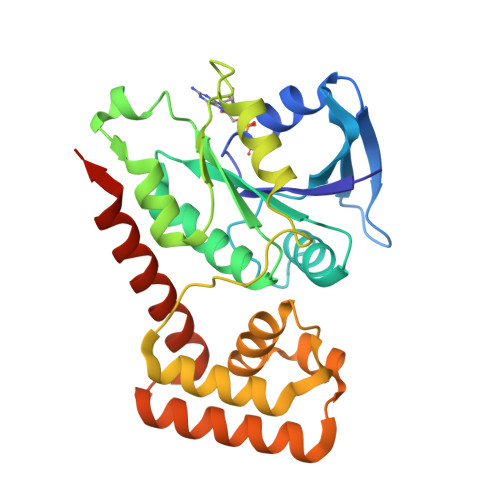A suite of Switch I and Switch II mutant structures from the G-protein domain of FeoB
Ash, M.R., Maher, M.J., Guss, J.M., Jormakka, M.(2011) Acta Crystallogr D Biol Crystallogr 67: 973-980
- PubMed: 22101824
- DOI: https://doi.org/10.1107/S0907444911039461
- Primary Citation of Related Structures:
3B1V, 3B1W, 3B1X, 3B1Y, 3B1Z - PubMed Abstract:
The acquisition of ferrous iron in prokaryotes is achieved by the G-protein-coupled membrane protein FeoB. This protein possesses a large C-terminal membrane-spanning domain preceded by two soluble cytoplasmic domains that are together termed 'NFeoB'. The first of these soluble domains is a GTPase domain (G-domain), which is then followed by an entirely α-helical domain. GTP hydrolysis by the G-domain is essential for iron uptake by FeoB, and various NFeoB mutant proteins from Streptococcus thermophilus have been constructed. These mutations investigate the role of conserved amino acids from the protein's critical Switch regions. Five crystal structures of these mutant proteins have been determined. The structures of E66A and E67A mutant proteins were solved in complex with nonhydrolyzable GTP analogues, the structures of T35A and E67A mutant proteins were solved in complex with GDP and finally the structure of the T35S mutant was crystallized without bound nucleotide. As an ensemble, the structures illustrate how small nucleotide-dependent rearrangements at the active site are converted into large rigid-body reorientations of the helical domain in response to GTP binding and hydrolysis. This provides the first evidence of nucleotide-dependent helical domain movement in NFeoB proteins, suggesting a mechanism by which the G-protein domain could structurally communicate with the membrane domain and mediate iron uptake.
Organizational Affiliation:
School of Molecular Bioscience, University of Sydney, NSW 2006, Australia.




















